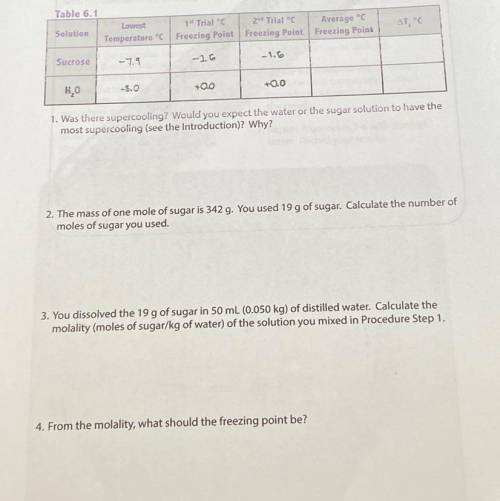
Chemistry, 05.03.2021 19:10 josephgperez
I’ll give brainliest 1. Use the balance and the 30-ml beaker places to measure 19 g of table sugar. To do this, place the beaker on the balance, the zero the balance. Add sugar to the beaker until the balance reads 19g. Mix the sugar with 50 mL of distilled water in the 150 mL beaker, stir until dissolved.
2. Prepare an ice bath in clear cup by filling it nearly full of ice. Put a small amount of cold water into the cup and then add about 1 tablespoon of table salt over the ice. Stir this with the tablespoon and measure the temperature. While stirring, continue to add table salt to the cup until the temperature is -15°C or lower.
3. Fill a test tube about 2/3 full with the sucrose solution.
4. Places the thermometer in the test tube. Hold the thermometer and the test tube together so the thermometer stays in the place in test tube and place this in the ice bath. Be careful not to get any salt water from the cup into the test tube.
5. While holding the test tube thermometer assembly, observe for the formation of ice crystals. The temperature when ice crystals first form may be below the normal freezing temperature (The solution may become supercooled). Record the lowest observed temperature just as the ice crystals first form. Remove the test tube thermometer assembly from the ice bath. Wait for most of the ice to melt. This will be the freezing point. Record the temperature in table 6.1.
6. Let the remainder of the ice in the test tube melt completely. Repeat procedures 4-6 once more and record the results.
7. Repeat procedures 3-6 with distilled water. Record your results


Answers: 2
Another question on Chemistry


Chemistry, 22.06.2019 15:30
Each of the following reactions is allowed to come to equilibrium and then the volume is changed as indicated. predict the effect (shift right, shift left, or no effect) of the indicated volume change. drag the appropriate items to their respective bins.co(g) + h2o(g) < => co2(g) + h2(g) (volume is decreased) pcl3(g) + cl2(g) < => pcl5(g) (volume is increased) caco3(s)< => cao(s) + co2(g) (volume is increased)
Answers: 1

Chemistry, 22.06.2019 20:30
From the choices provided below, list the reagent(s) in order that will react with cyclopentanone to form the compound shown below.
Answers: 2

Chemistry, 22.06.2019 23:00
What is the energy in joules of a mole of photons associated with visible light of wavelength 486 nm?
Answers: 3
You know the right answer?
I’ll give brainliest 1. Use the balance and the 30-ml beaker places to measure 19 g of table sugar....
Questions

Medicine, 08.01.2021 17:20

History, 08.01.2021 17:20


Geography, 08.01.2021 17:20

Social Studies, 08.01.2021 17:20



Computers and Technology, 08.01.2021 17:20


Mathematics, 08.01.2021 17:20




Social Studies, 08.01.2021 17:20

Mathematics, 08.01.2021 17:20


World Languages, 08.01.2021 17:20






